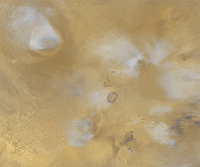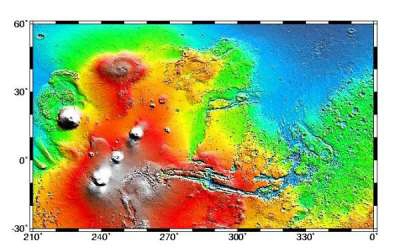Martian Volcanism and tectonics
|
Forces that shape the Martian surface
Olympus Mons, the largest volcano in the solar system, is of truly gargantuan proportions. Not only is it 27km high, more than three times the height of Mount Everest, it is also 550km in diameter and is rimmed by a 6km high escarpment. Once over this ridge, the first humans to climb it will have a very long, but gentle climb: its slope is only 2-5o. Olympus Mons lies off the north-west flank of the Tharsis region, a bulge in the Martian crust 4000km wide and 10km high. Situated on the rise are three more volcanic giants: Ascraeus Mons, Pavonis Mons and Arsia Mons. Elysium Planitia, another, smaller area of high ground, also boasts large volcanoes, although not as large as those associated with Tharsis. They are Hecates Tholus, Elysium Mons and Albor Tholus. Up-welling mantle
The Tharsis and Elysium bulges are deformations in the Martian crust caused by pressure in the underlying mantle. The volcanoes formed where the up-welling mantle pushed holes into the overlying crust. The regions are the youngest on Mars: the tectonic processes that shaped them switched off last (but see Mars may still be volcanically active). Volcanism probably began on Mars about 4.2 billion years ago, just a few hundred million years after the planet’s birth and shortly after the end of heavy bombardment by the numerous planetismals that populated the solar system at the time. The impacts left huge craters, such as the Hellas Basin, with highly fractured floors. “We believe that volcanism came to the surface through these fractures,” says Philippe Masson, from the Laboratoire de Géologie Dynamique de la Terre et des Planètes, Orsay, France. Evidence for that early volcanism still exists in the ancient rocks of the southern hemisphere, which have been undisturbed by major tectonic activity ever since. “Volcanic activity was global in the beginning, then it retreated to the north where it went on for while. Finally it retreated to Tharsis where we think it stopped,” says Tilman Spohn, from the Universität Münster, Germany. Nobody knows why major tectonic activity and volcanism switched off around the planet in this way, in particular why Tharsis and Elysium ended up as the only areas of tectonic activity. However, it’s not surprising that the bulges should be associated with large volcanoes. “As Tharsis pushed up, it split the crust. The three volcanoes on the dome are aligned – they’re probably all on the same underground fault,” says Masson.
Regional map of the Tharsis dome (high elevation to the west) and Chryse outflow basin (low lying region to the east) (MOLA Science Team) Split in the crust The raising of the Tharsis dome is also linked to another remarkable Martian feature, the Valles Marineris, a deep gash in the crust which runs east-west for almost a fifth of the planet’s circumference. It dominates images of the red planet taken from the right side. “In high resolution images, we can see that faults associated with the Tharsis dome played a role in the formation of the canyon. However, erosional processes due to landslides and water took place at different times and contributed to the enlargement of the canyon,” says Masson. Why did the Martian volcanoes grow so big? The answer, most are agreed, is because Mars is a one plate planet – or at least it has been since early in its history (see magnetism). This makes it quite different from the Earth whose crust is fractured into several discrete plates which move in relation to each other by floating on underlying molten mantle. The size of Earth’s volcanoes is limited because the crust eventually moves away from mantle hotspots. On Mars, the same crust has remained above the hotspots for billions of years, allowing volcanoes to grow and grow. |











